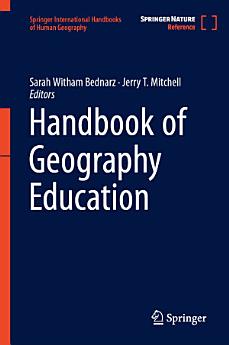Handbook of Geography Education
Über dieses E-Book
The book is divided into five sections:
· Purposes of geography education—Why is it taught?
· Perspectives on geography education—Whatis taught?
· Practices of geography education—How is it organized and taught?
· Preparation of geography educators—How are geography educators prepared?
· Possibilities for geography education—What is/are the future(s) of geography education
By providing broad perspectives and lively and accessible writing, this handbook is a useful tool for novice geography educators, teacher educators, educational policy makers, support staff such as librarians and media resource specialists, curriculum developers, and assessment experts in many world regions.
Autoren-Profil
Sarah Witham Bednarz is Professor Emerita in Geography, Texas A&M University, College Station, Texas. She was educated at Mount Holyoke College (A.B. 1973); the University of Chicago (M.A.T. 1974); and Texas A&M University (Ph.D. 1992). She served as president of the American Association of Geographers (2015–2016) and has a long affiliation with the Commission on Geography Education, International Geographical Union. Previously, she was associate dean for academic affairs in the College of Geosciences (2008–2014). Sarah’s research interests are in the intersection of teaching and learning geospatial technologies and spatial and geographic thinking. She was PI on two
major curriculum and educational research projects; co-authored the national geography standards, Geography for Life (1994 and 2012); participated in the National Research Council’s Learning to Think Spatially project; and helped to develop the National Assessment of Educational Performance (NAEP) framework in geography. In 2013 she co-chaired the Geography Education Research Committee (GERC) of the 21st Century Road Map for 21st Century Geography Education Project. She holds a University Professorship for Teaching Excellence, received the Gilbert H. Grosvenor Honors for Geographic Education (2007), and was an inaugural American Association of Geographers (AAG) Fellow.
Jerry T. Mitchell is Department Chair and a Professor of Geography at the University of South Carolina, Columbia, South Carolina. He holds degrees in History (B.S. 1991) and Geography (M.A. 1993) from Towson University, and a Ph.D. in Geography (1998) from the University of South Carolina. He is the Director of the Center of Excellence for Geographic Education and has authored more than 75 articles and book chapters in the fields of environmental hazards and geography education, with work appearing in journals such as Natural Hazards Review, Cartography and GIS, The Geography Teacher, and the Annals of the American Association of Geographers. This work was made possible by external funding from the National Science Foundation, Verizon Foundation, National Geographic Society, and others. He was the coordinator of the South Carolina Geographic Alliance (2004–2021), providing geography learning opportunities for more than 40,000 teachers and students. Additionally, he served as the Editor of the Journal of Geography from 2010 to 2019, was President of the National Council for Geographic Education in 2020, and was awarded the 2022 Gilbert H. Grosvenor Honors for Geographic Education from the American Association of Geographers.





